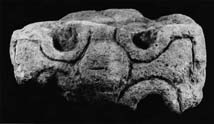Select a site alphabetically from the choices shown in the box below. Alternatively, browse sculptural examples using the Forward/Back buttons.
Chapters for this volume, along with copies of original in-text images, are available here.
Object type: Part of cross-head
Measurements: H. 19.6 cm (7.75 in); W. 39.7 cm (15.6 in); D. 19.5 > 15.5 cm (7.75 > 6 in)
Stone type: Fine-grained, white (10YR 8/1) limestone, with fossil debris; Hildenley Limestone, Coralline Oolite Formation, Middle Oxfordian, Upper Jurassic; probably reused from Roman fort near by, originally from Hildenley, near Malton (see Fig. 5)
Plate numbers in printed volume: 737-740
Corpus volume reference: Vol 3 p. 197
(There may be more views or larger images available for this item. Click on the thumbnail image to view.)
The fragment consists of the lateral arms of a disk- or plate-head cross; the arm-type approximates to A10.
A (broad): The surface is convex. In the centre is a domed boss. From its edges an incised line marks the edge moulding of the hammer-headed arms. The arm-pits are three-quarter circles, the surface recessed deeply with the punch.
B (narrow): The end of the better preserved arm has a plain edge moulding as broad as those of the principal faces containing a large incised circle.
C (broad): Identical with face A except for the central boss. The surface is much more worn and broken, though on the left-hand arm is an incised circle.
D (narrow): The other arm end is heavily damaged. Above the arms are protrusions which suggest a plate recessed from the face of the cross-arms. Its edge has some incisions which may be remains of an edge moulding.
The hammer form of the cross-arms and their slightly convex ends are reminiscent of late Anglian forms throughout Northern England. The disk-like head, or plate-head, whilst common in Allertonshire, North Riding, in a more open form, is more like heads at Whithorn, Galloway; this connection was noted by Collingwood in his discussion of a fairly close parallel for Old Malton 2 at High Hoyland in the West Riding (Collingwood 1915, 185, figs. h, i on 184).



